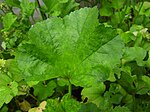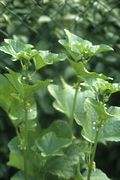|
Malva verticillata
Malva verticillata, also known as the Chinese mallow[1] or cluster mallow,[2] is a species of the mallow genus Malva in the family of Malvaceae found in East Asia from Pakistan to China. M. verticillata is an annual or biennial that grow up to 1.7 meters in high and can inhabit woodland areas of different soil types. The small, symmetrical flowers have five white, pink or red petals (0.8 cm) and thirteen or more stamens. Each flower has three narrow epicalyx bracts. The fruit is a dry, hairless nutlet. The leaves are simple and alternate.[3] In temperate climates, it flowers from July to September and the seeds from August to October. The flowers of the plant are self-fertile but can also be pollinated by insects.[4] DistributionThe species originates in Asia. It is widely distributed in Europe and is considered an invasive plant.[5] It is also present in North America, including most states in the USA.[3] UsesThe plant was an important leaf vegetable in pre-Han China and widely cultivated.[6] Mallow is mentioned in Huangdi Neijing as one of the five consumable herbs (五菜) which included mallow (葵), pea leaves (藿), Allium macrostemon (薤), Welsh onion (蔥) and Garlic chives (韭).[7] It is mentioned in the Zuo Zhuan in Duke Cheng's reign by Confucius to compare to the head of the Bao clan saying he is not as smart as a kuicai (mallow) because it keeps its roots to the ground. It was deemed to be a major vegetable until the Northern Wei, supposedly. The technology for domesticating mallow was well recorded in Qimin Yaoshu. The acreages dwindled since the Tang dynasty. In his Nong Shu [Agricultural Manual], Wang Zhen wrote that mallow came top among various vegetables, because "it could be alternative in years of crop failure, or be marinated to serve with staples". There were rare occasions that people cultivated or consumed mallow during the Ming dynasty.[8] It is also grown as an ornamental plant.[3] References
External links
|
||||||||||||||||||||||||||||||



